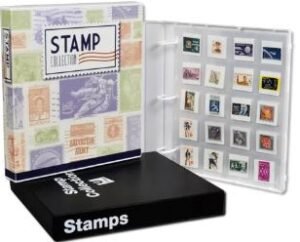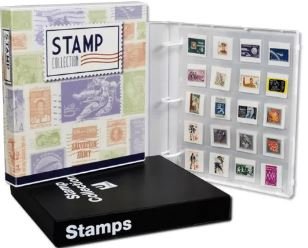Stamp collecting, or philately, is a rewarding hobby that can offer both enjoyment and financial gain. Whether you collect stamps for their historical significance, artistic beauty, or investment potential, one thing is certain: proper storage is crucial. How you store stamps long term can significantly impact their condition and value. In this article, we’ll explore how to store stamps long term to ensure that your collection is preserved for future generations and maintain its value. Without the right storage methods, stamps can deteriorate, lose their color, or even be ruined. Let’s dive into how to store stamps long term and avoid these risks.

Why Proper Storage is Crucial for Stamps
Stamps are delicate items that can suffer damage from various environmental factors. Whether you’re collecting rare first editions, commemorative stamps, or common postal issues, knowing how to store stamps long term is essential to keeping your collection intact. Exposure to light, moisture, air, and improper handling can cause irreversible damage, decreasing a stamp’s aesthetic and financial value. With proper care, however, stamps can remain in pristine condition for decades, making how to store stamps long term a fundamental consideration for any serious collector.
How to Store Stamps Long Term: Tips for Preserving Value
1. Use Proper Storage Containers
One of the most important factors in how to store stamps long term is choosing the right storage containers. Ordinary envelopes and plastic bags won’t do the trick. You should always store stamps in specialized stamp albums or stock books designed specifically for philatelic items. These albums typically have acid-free pages that protect stamps from moisture and pollutants. Look for albums with clear, transparent pockets to allow you to view your stamps without handling them directly.
If you prefer to store your stamps more securely, stamp storage boxes or protective glassine envelopes are excellent choices. These are designed to protect from light, air, and dust, which can all negatively affect your collection over time. By using the right containers, you can ensure that your collection is protected while still being easy to access.
2. Keep Stamps in a Cool, Dry Place
Environmental factors play a critical role in how to store stamps long term. Stamps should be kept in a location that is cool, dry, and stable. Excessive heat can cause stamps to become brittle and discolored, while humidity can lead to mildew and mold growth, both of which are detrimental to your collection. The ideal storage area should have a temperature between 65°F and 75°F (18°C to 24°C) and a relative humidity level between 40% and 60%.
Avoid storing stamps in attics, basements, or other areas subject to temperature fluctuations and high humidity. Instead, choose a place like a dedicated drawer or a cabinet that is away from direct sunlight and potential sources of moisture. The way you store stamps long term can make the difference between preserving their value or seeing them deteriorate over time.

Stamp collecting, or philately, is a popular hobby for many people around the world, and in the USA, it has become a lucrative market for both enthusiasts and investors alike. One key aspect of stamp collecting is ensuring that the stamps in your collection are accurately graded and valued read more.
3. Use Acid-Free Materials
Acid is one of the most damaging substances for stamps, as it can cause yellowing and deterioration over time. To avoid this, always choose acid-free storage materials for storing your stamps. This includes acid-free albums, stock books, and glassine envelopes. Avoid using cardboard, PVC plastic, or other non-archival materials that can introduce acid to your stamps. Acid-free materials are specifically designed to prevent this damage and ensure that your collection remains in top condition.
In addition, when handling stamps, wear cotton gloves to prevent oils and dirt from your fingers from transferring to the stamps. This simple step will help you maintain the integrity of your collection for many years to come.
4. Avoid Exposure to Light
Light is another enemy of stamp preservation, especially ultraviolet (UV) light, which can cause fading and discoloration over time. When considering how to store stamps long term, it’s essential to minimize exposure to light. If possible, store your stamps in a dark or low-light area, and if you keep them in an album, ensure that the pages are kept closed to limit light exposure.
If you display your stamps or keep them in an area with natural light, consider using UV-protective glass in frames or placing your albums in areas that don’t receive direct sunlight. The more you protect your stamps from light, the better their chances of retaining their original color and appearance.
5. Handle with Care
When considering how to store stamps long term, it’s important to remember that how you handle your stamps is just as important as how you store them. Stamps are fragile, and rough handling can cause creases, tears, or damage to perforations. Always handle stamps carefully, holding them by the edges and never touching the face or adhesive side. Use tongs or tweezers designed for stamp collecting to avoid touching the stamps with your fingers.
Proper handling ensures that your stamps stay in top condition and are preserved for years to come. By handling stamps carefully and using appropriate tools, you can avoid the risk of accidental damage and preserve their value.
How to Store Stamps Long Term: What to Avoid
To successfully protect your stamps, you must also know what to avoid in your storage practices. Here are some mistakes to watch out for when considering how to store stamps long term:
- Storing Stamps in Plastic Sleeves Without Protection: Many collectors make the mistake of storing their stamps in cheap plastic sleeves that aren’t archival quality. These plastic sleeves can introduce acid and cause the stamps to deteriorate over time. Always opt for archival-grade materials to store your stamps.
- Ignoring Temperature and Humidity Control: While it may seem like a small detail, the environment in which you store your stamps plays a vital role in their longevity. Avoid storing stamps in places where temperature and humidity are uncontrolled, as this can lead to long-term damage.
- Overcrowding Stamps in Albums or Boxes: Another mistake is overcrowding. When storing stamps long term, make sure there’s enough space to store them properly. Overcrowding can cause stamps to become bent or damaged, reducing their value. Allow for ample space in your storage materials to protect each stamp.

Conclusion
In conclusion, how to store stamps long term is a crucial factor in maintaining the condition and value of your collection. By following the tips outlined in this article—using proper storage containers, keeping your stamps in a cool and dry environment, using acid-free materials, and handling stamps with care—you can ensure your collection lasts for years to come. The right storage methods will help you preserve the beauty, authenticity, and value of your stamps, while improper storage will only lead to deterioration and possible financial loss. Whether you’re a beginner or an experienced philatelist, understanding how to store stamps long term is essential for any serious collector.




